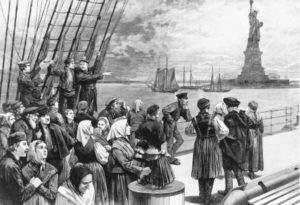The Irish in America
Part II
See part 1 here.
“Give me your tired, your poor,
Your huddled masses yearning to breathe free,
The wretched refuse of your teeming shore.
Send these, the homeless, tempest-tost to me,
I lift my lamp beside the golden door!”
Emma Lazarus, The New Colossus, 1883
This protracted starvation brought about by the Irish Potato Famine caused the slow and suffering deaths of over one million Irish, and led to the Irish Diaspora, a massive migration of Irish citizens from their homeland to more promising shores.

The Irish who arrived in America brought along with them their lilting brogues, their customs, their songs, their dances, their superstitions, and most of them brought a religion that was as yet fairly foreign to America: Roman Catholicism.
And they also brought with them a strong dislike for anything English. From the start, the Irish were regarded as inferior by those who were already established here, and found it hard to find work at the factories which hung signs in their windows saying “N.I.N.A.” (No Irish Need Apply). But there was something else the Irish had brought with them, and it served them well: They brought their strong Irish will. They were a stubborn and tenacious lot, who had survived starvation, misery, despair and cruelty.
They came here under the most strenuous conditions and made this country their own. Many of them, upon arriving here, would find work building the nation’s roads and railroads, and would learn the skills that would make them useful to the construction trades; and many others would become farmers.
When West Haven’s sewer lines were laid in 1914, the process was fulfilled by the sweat of hundreds of Irish laborers, armed with picks and shovels, who served as “ditch diggers” and helped our community to move forward. In addition, many Irish became involved in the American political process, and advanced themselves through their association with it.
It should be noted that when it comes to gallantry and valor in battle, few groups have distinguished themselves like the Irish have.
Even before the War Between the States was concluded, the Irish had earned the grudging respect of established Americans on both sides of the Mason-Dixon Line. Perhaps this was their first step in becoming respected and accepted in their new country.
As the years passed, the Irish in America grew in esteem and influence, and today, this group that once was downtrodden, has set an excellent example of how an ethnic group can assimilate and succeed and rise in their new American surroundings.
And finally, there is the story of one Irish immigrant, a master stonemason named John Patrick Shine, who came to West Haven from County Cork in Ireland in 1898, along with his wife, Mary Roddy Shine. They settled on Peck Avenue and had ten children.
John Shine distinguished himself in the community by his leadership in the building of the “new” Christ Church on Church Street, which was completed in 1907. Interestingly enough, one cannot help but note that the lettering on the church’s corner stone is cut in an Irish script!